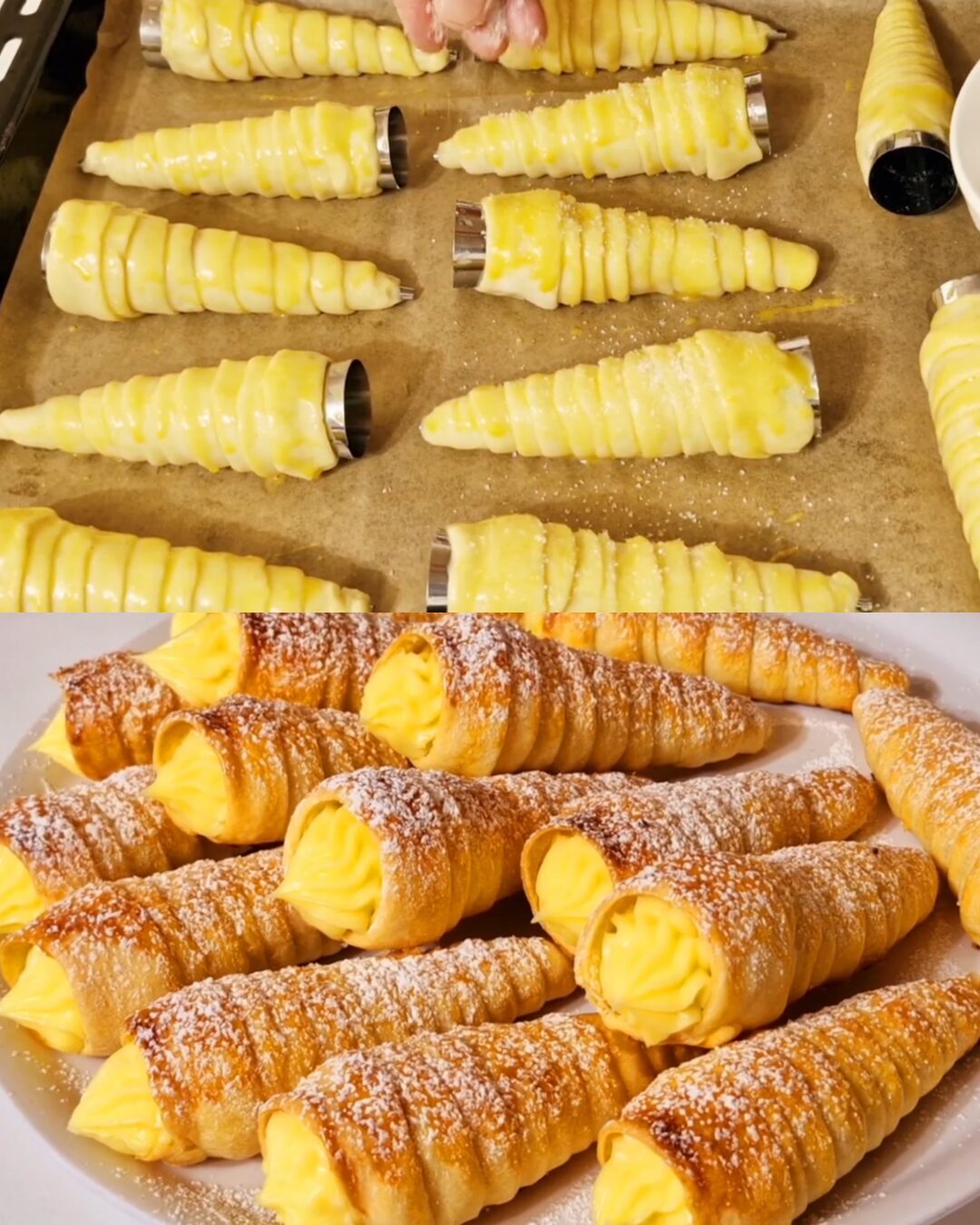The egg custard tart is a timeless dessert that has graced tables across Europe and beyond for centuries. With its silky vanilla custard nestled in a buttery, flaky crust, this tart offers a delightful contrast of textures and flavors. Whether enjoyed warm or chilled, it’s a comforting treat that evokes nostalgia and satisfaction.
Cooking Time
-
Preparation Time: 30 minutes
-
Chilling Time: 40 minutes
-
Baking Time: 20 minutes
-
Total Time: Approximately 1 hour and 30 minutes
Ingredients
For the Custard Filling:
-
1 egg yolk
-
70 g granulated sugar
-
30 g cornstarch
-
300 ml milk
-
50 g unsalted butter
-
10 g vanilla sugar
For the Pastry Dough:
-
300 g all-purpose flour
-
170 g unsalted butter, cold and cubed
-
80 ml cold water
-
1 small egg
-
Pinch of salt
-
1 tsp 9% vinegar
For Assembly:
-
1 egg yolk (for egg wash)
-
Granulated sugar (for sprinkling)
-
Powdered sugar (for dusting)
Step-by-Step Cooking Directions
-
Prepare the Custard Filling:
-
In a saucepan, whisk together the egg yolk, granulated sugar, and cornstarch until smooth.
-
Gradually add the milk, whisking continuously to avoid lumps.
-
Place the saucepan over medium heat and bring the mixture to a boil, stirring constantly until it thickens.
-
Remove from heat and stir in the butter and vanilla sugar until fully incorporated.
-
Transfer the custard to a bowl, cover with plastic wrap touching the surface to prevent a skin from forming, and let it cool to room temperature.
-
-
Prepare the Pastry Dough:
-
In a large bowl, combine the flour and a pinch of salt.
-
Add the cold, cubed butter and rub it into the flour using your fingertips until the mixture resembles coarse breadcrumbs.
-
In a separate bowl, whisk together the cold water, small egg, and vinegar.
-
Gradually add the wet mixture to the flour mixture, mixing until a dough forms. Do not overwork the dough.
-
Shape the dough into a disc, wrap it in plastic wrap, and refrigerate for 30–40 minutes.
-
-
Assemble the Tart:
-
Preheat the oven to 200°C (392°F).
-
On a lightly floured surface, roll out the chilled dough to a thickness of approximately 3 mm.
-
Line a tart tin with the rolled-out dough, trimming any excess.
-
Prick the base of the pastry with a fork to prevent it from puffing up during baking.
-
Pour the cooled custard filling into the prepared pastry shell, smoothing the top with a spatula.
-
In a small bowl, beat the egg yolk for the egg wash and brush it over the exposed edges of the pastry.
-
Sprinkle a little granulated sugar over the custard surface for a caramelized finish.
-
-
Bake the Tart:
-
Place the tart in the preheated oven and bake for about 20 minutes, or until the custard is set and the pastry is golden brown.
-
Remove the tart from the oven and allow it to cool in the tin for 10 minutes.
-
Transfer the tart to a wire rack to cool completely.
-
-
Serve:
-
Once cooled, dust the tart with powdered sugar.
-
Slice and serve as desired.
-
Nutritional Information (Per Serving, based on 8 servings)
-
Calories: 320 kcal
-
Protein: 5 g
-
Fat: 18 g
-
Carbohydrates: 35 g
-
Sugar: 15 g
-
Fiber: 1 g
-
Sodium: 120 mg
Note: Nutritional values are approximate and may vary based on specific ingredients used.
Origins and Popularity of the Recipe
The egg custard tart has deep roots in European culinary traditions. In Britain, it’s a staple of classic baking, often enjoyed with a sprinkle of nutmeg. In Portugal, the “Pastel de Nata” is a beloved variation, characterized by its caramelized top and flaky pastry. The French “Flan Pâtissier” offers a richer, creamier version, showcasing the versatility and widespread appeal of this dessert.
Reasons Why You’ll Love the Recipe
-
Timeless Appeal: A classic dessert that never goes out of style.
-
Simple Ingredients: Made with pantry staples, making it accessible and convenient.
-
Versatile Serving Options: Delicious both warm and chilled, suitable for various occasions.
-
Customizable: Can be flavored with spices like nutmeg or citrus zest for a personal touch.
Health Benefits
While indulgent, this tart provides:
-
Calcium: From the milk and butter, supporting bone health.
-
Protein: From the eggs and milk, essential for body repair and maintenance.
-
Energy: A good source of carbohydrates and fats for energy.
As with all treats, moderation is key.
Serving Suggestions
-
Warm with Tea or Coffee: A comforting pairing for afternoon breaks.
-
Chilled with Fresh Berries: Adds a refreshing contrast to the creamy custard.
-
With a Dollop of Whipped Cream: Enhances the richness for special occasions.
Common Mistakes to Avoid
-
Overcooking the Custard: Leads to a grainy texture. Bake until just set.
-
Underbaking the Pastry: Results in a soggy bottom. Ensure the pastry is golden and crisp.
-
Not Chilling the Dough: Makes it harder to handle and can cause shrinkage during baking.
Pairing Recommendations
-
Beverages: Pairs well with black tea, coffee, or dessert wines like Moscato.
-
Fruits: Fresh berries, poached pears, or citrus segments complement the richness.
-
Sauces: A drizzle of raspberry coulis or caramel sauce adds depth.
Cooking Tips
-
Use Cold Butter: Ensures a flaky pastry texture.
-
Chill the Dough: Prevents shrinkage and makes it easier to handle.
-
Strain the Custard: For an ultra-smooth filling, strain before pouring into the pastry shell.
Similar Recipes to Try
-
Portuguese Pastel de Nata: Features a caramelized top and puff pastry crust.
-
French Flan Pâtissier: A thicker custard tart with a shortcrust base.
-
Hong Kong Egg Tarts: A fusion of British and Cantonese flavors with a delicate crust.
Variations to Try
-
Spiced Custard: Add cinnamon or nutmeg to the custard for warmth.
-
Citrus Zest: Incorporate lemon or orange zest for a zesty twist.
-
Chocolate Swirl: Mix in melted chocolate for a marbled effect.
Ingredient Spotlight
Cornstarch: A key thickening agent in the custard, cornstarch ensures a smooth, stable filling. It’s essential to whisk it thoroughly with the milk to prevent lumps and achieve the desired consistency.
Conclusion
The classic egg custard tart is a testament to the beauty of simple ingredients coming together to create something truly delightful. Its rich history and universal appeal make it a cherished dessert across cultures. Whether you’re a seasoned baker or a novice, this recipe offers a rewarding experience and a delicious outcome.
Frequently Asked Questions
1. Can I use whole eggs instead of just the yolk in the custard?
Yes, but using only the yolk results in a richer, creamier texture. Whole eggs can make the custard firmer.
2. How do I prevent the pastry from shrinking during baking?
Ensure the dough is well-chilled before rolling out and avoid overworking it. Also, allow the lined tart tin to rest in the fridge before baking.
3. Can I make the tart ahead of time?
Absolutely. The tart can be made a day in advance and stored in the refrigerator. Dust with powdered sugar just before serving.
4. Is it necessary to blind-bake the pastry?
In this recipe, blind baking isn’t required as the custard and pastry bake together. However, if you prefer a crisper base, you can blind-bake the pastry for 10 minutes before adding the filling.
5. Can I freeze the custard tart?
Yes, wrap it tightly and freeze for up to a month. Thaw in the refrigerator overnight before serving.
6. What can I use instead of vanilla sugar?
You can substitute with 1 teaspoon of vanilla extract or the seeds from half a vanilla bean.
7. How do I know when the custard is set?
The custard should be slightly wobbly in the center but firm around the edges. It will continue to set as it cools.
Advertisement
8. Can I add fruit to the custard tart?
Yes, layering thin slices of fruit like apples or pears on the base before adding the custard can add flavor and texture.
9. Why is my custard lumpy?
Lumps can form if the custard is overcooked or not stirred continuously. Straining the custard before pouring it into the pastry shell can help achieve a smooth texture.
10. Can I use store-bought pastry?
Yes, using pre-made shortcrust or puff pastry can save time. Ensure it’s rolled out to the appropriate thickness and fits your tart tin properly.

